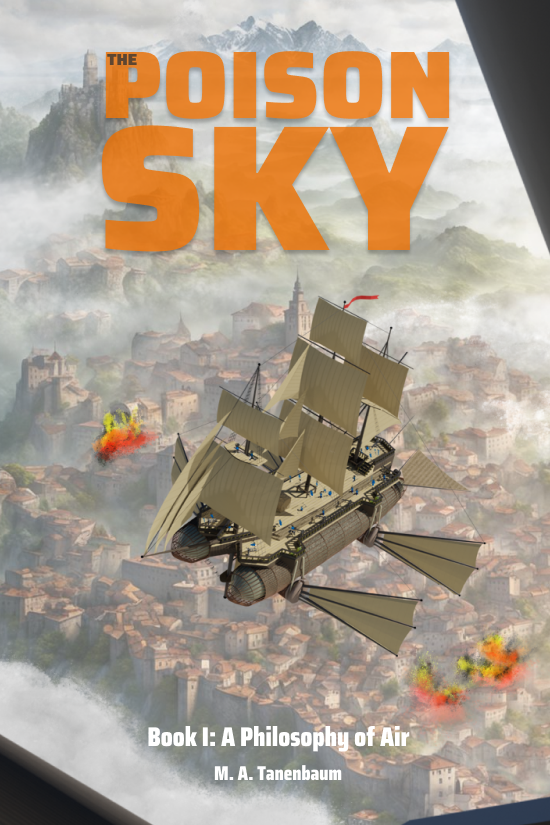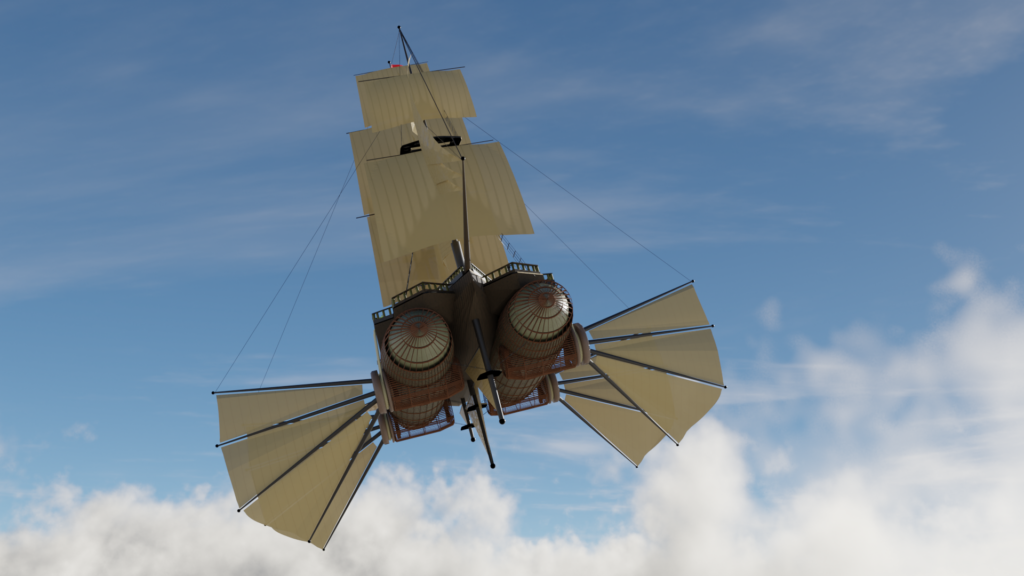This scene may never be part of A Philosophy of Air. It’s more of an exercise intended to clarify in my own mind all the roles aboard the airship which is the stage for so much of my story.
I’m posting it here because I absolutely welcome all well-intentioned feedback, from the writing style to comments on specific details.

With regards to the latter, I’m obviously drawing from Age of Sail sources (most especially White Jacket, The Wager, Two Years Before the Mast, and the Patrick O’Brian novels), but there are two important points of divergence. First, obviously, I’m describing an airship in a fantasy world: three dimensions, the change of element, and a measure of suspension of disbelief all demand certain changes. Second, my world does not have gunpowder, a point which will become evident in the description of the weaponry.
To the landsman, it may seem surprising in a world restricted to some five hundred hands in length and a good deal less wide, a tiny island unto itself, that a man might not know the name — or at least the face — of every other man aboard, together with his rank, his station, and a good deal more besides. Still more so for anyone with Nym’s keenly observant eye. Yet such is the rigid organization and compartmentalization aboard His Majesty’s airships, so deeply had he been buried in the Harald Jorem’s bowels among the waisters, that across his months of service he had rarely seen the main deck, let alone the quarter, rarely counted the men in the rigging nor understood how the many human gears meshed aboard ship. Only now, in his new capacity as ship’s clerk, had he time and freedom enough to examine in detail this clockwork piece, this flying city which could transform itself at a moment’s notice into an engine of destruction.
No less than two hundred men inhabited a stormchaser, and while their occasional deaths due to weather, accident, disagreement (no small consideration in a wooden box overstuffed with burly, belligerent airmen), and sometimes combat meant a steady churn of new faces, there was nevertheless a constancy and daily routine that made this ebb and flow seem almost normal.
The reigning potentate of this city was Captain Gunnarsson, assisted by his three lieutenants: Ulricsson, Jensson, and Skulisson, and woe betide the man who failed to understand and fear their authority. Nym had found the old saying — “aboard ship, the captain is harald, the captain is God.” — unambiguously true, and only slightly less did this apply to his lieutenants. Under the Articles of War, while asky any of these men could mete out punishments, from hard duty to flogging to death, with hardly any recourse to a higher authority…certainly no authority that would prevent them carrying out their will in time to do you any good.
Below these mighty men stood the ship’s other senior officers. The ship’s master, Orsson, navigated. The master-at-sail, a Windlander named Chen, deftly coordinated the many sail crews required to steer the ship, under the direction of the master and sometimes of the captain himself. Harksson, the purser, likewise directed all the ship’s funds, releasing money with one hand, snatching it away with the other when he could. Finally among this set was Ivarsson, the boatswain, whose role seemed to comprise a range of activities: he was town crier in this little city, making announcements and blowing the whistle that summoned and banished men in every direction; he was further inspector general, ensuring the fitness of everything aboard ship not made of flesh or wood: sails, ropes, and sacks. Lastly, he was executioner, for Ivarsson and his mate held the unenviable job of meting out punishment, as Nym himself had experienced shortly after his arrival. No wonder the boatswain and his mate were universally despised by the sailors, though to be sure they did no more than their duty.
There were still more officers.
Eight midshipmen, young men and boys from better families who aspired to senior status and who rehearsed for this role by barking out orders they barely understood themselves, by learning how to furl and reef a sail, how to scale the rigging, how to make noon with a quadrant, how to read a kite-and-fettle and thereby have some vague notion of a ship’s position when beyond sight of land.
The guerriers, a group of twelve scarred and hardened landsmen who charged first when boarding an enemy and who besides enforced security aboard Jorem, had a captain, an oddly uptight and prim fellow named Vidarsson, who spoke in posh tones and whose uniform never saw a blemish, not even (so the men said) in battle.

After this august array of officers, but no less critical to the operation of the flying fortress, were the many craftsmen and specialists who ensured the good upkeep of the ship and crew. These included a carpenter to repair and refit the ship’s hull, its masts, and the sack’s protective housing; a sailmaker who maintained and repaired the towers of canvas above, to each side, and below the vessel; a sackmaker responsible for the hundreds of pallones keeping Jorem aloft; and a ropemaker who spliced and repaired the miles of line holding everything else together. All this simply to move the beast, but still not accounting for its fangs and claws. For these we must look to the artilleryman, whose job it was to maintain the ballistas and trebuchets; the armorer, who made and maintained the swords, bows, and arrows; the master-at-arms, who secured and kept track of all the weapons; and the twenty-four artillery captains who trained and directed the artillery crews.
Some few other specialists worked aboard the Jorem. These included the ship’s surgeon, a chaplain (who when not ministering to men’s souls also had responsibility for the midshipmen’s education), the cook, the captain’s private steward, the storemaster, king of the black underworld that was the ship’s hold, and the ship’s clerk…a role now occupied by Nym himself. Eight other men worked as various forms of ship’s mate, assisting the master-at-sail, the boatswain, and so forth. These were far more than functionaries, for each could replace his superior immediately should the need arise.
Lastly came the hands, and well-named they were, for these men, under the direction of those named above, applied just shy of three-thousand fingers to all the actual work of operating the ship. Thirty-six topmen scurried up and down the rigging, bending and furling and reefing sail. These were typically young, agile men, but well-experienced and full of courage, for as Nym had unwittingly learned, the sail tops offered no small measure of peril. There were then eighteen sheet-anchormen, the most experienced tars aboard ship, hard-bitten, well-seasoned, not a man among them without a limp, scar, or missing finger to prove his years. These men managed the foreyards, foresails, and catchsails, perhaps the most finicky and critical parts of the vessel, particularly when beating upwind. Another eighteen, the wingmen, managed the wingsails, and still another, the keelmen, looked after the sails beneath, those whose careful management had to be communicated from the master-at-sail by means of a hallo-pipe. There was one last group of eighteen, that of the afterguard, a set of men too well-bred to be common sailors, but not quite bred well enough to train as officers. As a consequence, they kept to themselves, mingling with the common men upon the main deck, po-faced with the knowledge that they would never rise in station. Few of these had real experience as airmen, so their roles comprised little more than the managing of the mainsail and spanker, those sails most directly under the eye of the master-at-sail, and requiring the least practical knowledge.
So much for the crew, except for those twenty-four sad wretches known as the waisters, such as Nym had been himself. These men, deemed good for nothing by all the world, lived the majority of their lives in the dark recesses of the hold, tending animals and cargo, or in their quarters on the orlop deck, rarely seeing light or sun or sky but through a porthole, or on those occasions when they were called up to the main deck to haul rope or witness punishment.
In battle, neat order was still to be found — at least until the ammunition flew — as each man had his action station. The captain ordering “beat to quarters,” all these two-hundred men arranged themselves, some to direct the ship, others to work a ballista or trebuchet, with even the least among them ready to deal a blow to an enemy. As a waister, Nym had loaded bolts into a ballista down on the orlop. Maintaining the ship’s books was curiously seen as rather low priority in the heat of battle, thus he had a similar station now: supplying grape and ball to a trebuchet on deck. That said, there was now an added complication: a man on deck might be ordered to leap over the top from his ship to another, crossing the yawning gap and the infinite fall below, to face the equally uninviting prospect of hand-to-hand combat with the enemy.
I hope you enjoyed this little glimpse into the world of A Philosophy of Air. Again, I welcome all feedback. Let me know what you think in the comments below.
This blog covers a variety of topics, including the development of this novel, my thoughts on writing, and my experience as a bicycle tour guide in San Francisco. If you find any of this interesting, please consider subscribing.
Leave a Reply